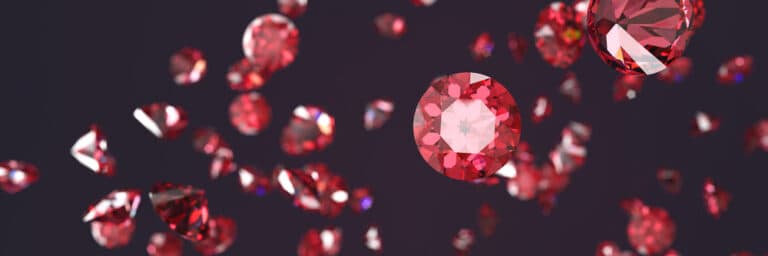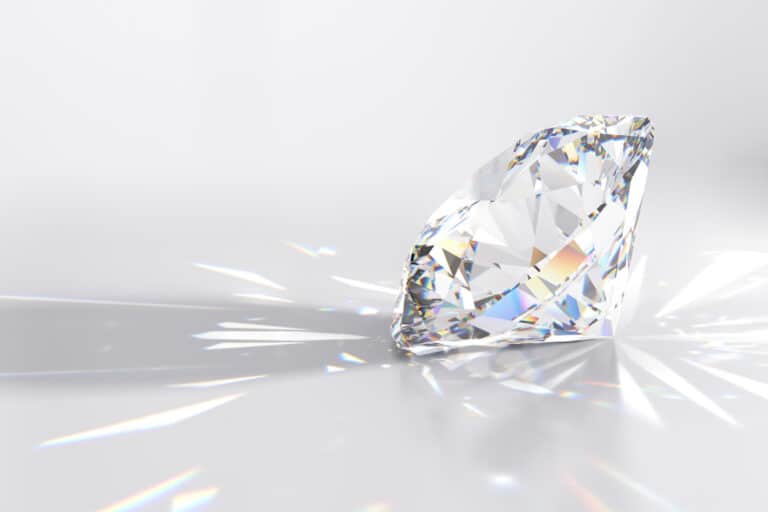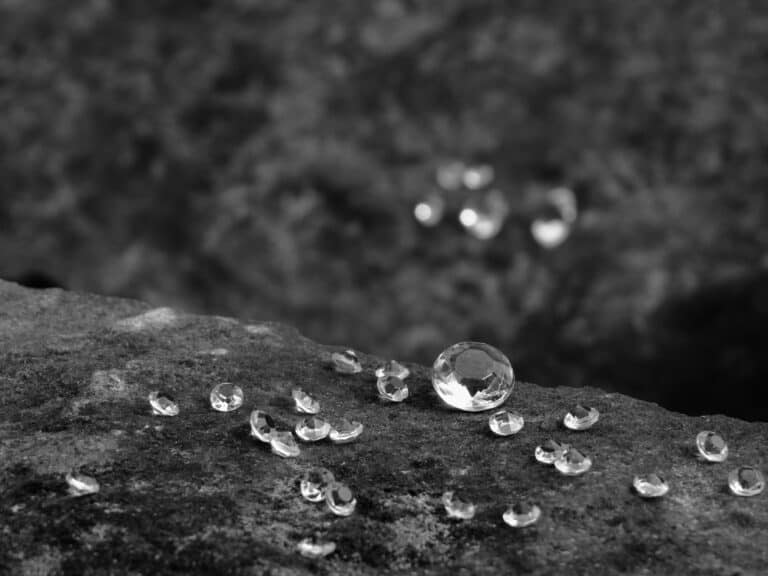Diamonds are forever. Most of us have heard that phrase, especially the men wanting to propose to their better half. The slogan has an ambiguous meaning which can symbolize the supposed “forever” union between two people in love or that nothing can destroy a diamond. How long do diamonds last?
Diamonds take billions of years to form inside the earth and will last for billions of years above the earth’s surface. Diamonds are not the most balanced form of carbon. However, the conditions on earth are insignificant in converting it into carbon’s most stable form, which is graphite.
After the Great Depression, diamond sales dropped, and De Beers sought a way to boost sales via a campaign. With a surplus of diamonds to sell, they approached the NW Ayer advertising group to help. Copywriter, Frances Gerety, coined the iconic phrase “A Diamond Is Forever” in 1947. Is it realistic to expect a diamond to exist forever?
How Long Do Diamonds Last?
When non-metal carbon (atomic number 6) merges with other carbon atoms, it creates allotropes (a multitude of unique structures.) A diamond is an allotrope of carbon, which takes an octahedral structure, where each carbon atom attaches to four other atoms. The result is a three-sided pyramid structure.
The tetrahedral structure of a diamond gives it the title of the “hardest material” found on earth. But there’s a catch. Diamonds are not the most balanced form of carbon; the most stable form of carbon is the stuff you find in pencil. We know it to be graphite.
Technically, diamonds are a metastable structure of carbon, which in chemistry terms means that diamonds as a structure will be stable under certain conditions, as typically found on earth. However, there’s a state that’s more stable than the metastable state of a diamond, the state when a diamond converts into graphite.
Graphite is a lower-energy configuration of crystalline carbon. In theory, the degradation from diamond state to graphite state will happen when atoms rearrange themselves internally and settle into a lower energy state. The problem is that the kinetic energy required for these atoms to change is virtually non-existent under normal conditions.
When you heat a diamond or attack it with ions, the atoms will gain enough kinetic energy to reconfigure themselves to graphite. It’s estimated that if you leave a diamond exposed to 25°F, it will take more than a billion years for the activation energy to convert one cubic centimeter of diamond to the stuff you find in pencil.
Luckily, the conditions found on earth are not conducive to forcing a diamond into its most balanced carbon form, which is graphite. If you keep a diamond in standard conditions, the rate at which it will turn to graphite is so slow and negligible that you can be sure that it will last for millions of billions of years, or like the slogan of De Beers, “Forever.”
How Long Do Diamonds Take To Form?
According to the Cape Town Diamond Museum, diamonds formed over 3 billion years ago when deep carbon deposits found within the earth’s core (90-125 miles from the surface) were exposed to extreme pressure (40-60 kilobars) and high temperatures (1652°F-2372°F.)
These intense conditions cause carbon atoms to crystallize and form diamonds, forming molten lamproite and kimberlite (magma) in the upper mantle, which expands at a meteoric rate. When the expansion causes magma to erupt, the diamond-bearing rocks are transported with the erupting magma, typically in a “pipe” to the surface.
When the magma cools down, it hardens to form Kimberlite, which is vertical structures called Kimberlite pipes (derived from the South African mining town Kimberley.) These diamond pipes are the source of most diamonds found today.
It’s quite the journey for a diamond to form and find its way to diamond sellers living on earth.
What Conditions Affects The Longevity Of A Diamond?
As mentioned above, a diamond will outlast generation upon generation, surviving millions of years if kept in the standard environment found on earth. In theory, none of us will be alive long enough to see any diamond meet its end by turning into graphite. Ever.
However, there are certain conditions and scenarios that can destroy a diamond and turn some parts of it into graphite.
Extreme Heat Will Turn Diamonds Into Carbon Dioxide
When placed in an atmosphere of pure oxygen, a diamond has an ignition point estimated between 1,274°F and 1,540°F. When placed in these conditions, a diamond will first burn red hot before turning into white heat, burning with a pale blue flame. Even if you remove the heat source, the diamond will continue to burn with a fire that looks like it’s dancing on the diamond.
When burning a diamond in the air, the combustion ceases as soon as the heat source is removed due to the oxygen being mixed with nitrogen. Keeping the heat source on the diamond will have the same outcome, as in both cases, a flawless diamond can be converted into carbon dioxide. If the diamond has any impurities, it will present itself as ash.
When cutting a diamond, the heat generated by the cutting instrument will not be enough to ignite the diamond or turn the area worked on into graphite. House fires and the flame from a blow torch are hot enough to destroy a diamond.
Smaller diamonds tend to burn easily, that’s why home insurance is so important in the case of fire. Never throw a diamond into a fire or furnace unless you are a woman scorned and want to financially hurt your soon-to-be ex-partner.
When you combine enough heat and oxygen (fuel), you will find that a diamond doesn’t last forever. Diamonds are made out of carbon; they can burn like coal. The heat and oxygen combo lead to combustion, where the diamond form carbon dioxide instead of reverting to graphite.
Diamonds Don’t React Well To Blunt Force Trauma
A diamond’s ability to resist breakage from a forceful impact is a mechanical property measured by its toughness. Although a diamond’s toughness compares well with other ceramic materials, it compares poorly to engineering materials such as alloy.
A diamond’s macroscopic geometry is a cleavage plane, making it fragile in certain orientations. A diamond cutter uses this fragility to cleave the stone before faceting it. While diamonds are extremely hard (to scratch and cut), they are considered extremely fragile regarding overall strength or tenacity.
Although diamonds have high-pressure resistance, they don’t respond well to shock treatment. A simple hammer can shatter a diamond into several shards. Drop an anvil on it and see how it’s crushed to smithereens. Diamonds can last forever, just as long as you don’t hit them with a hammer or drop an anvil on them.
Diamonds Used In Tools Don’t Typically Last Forever
Diamond tools are construction tools fitted with diamonds that can perform tasks that other normal tools struggle with. From mining bits that cut through rock, saw blades slicing through steel, and drilling attachments for drilling into metal, it makes perfect sense to use the hardest material on earth for the toughest jobs.
When you use a diamond in a cutting tool to grind or cut materials, extreme temperatures will always be at play where the diamond makes contact with the material. When the temperature gets too high when grinding, cutting, or drilling, the diamond can degrade to graphite and flake off, especially when an ion is involved at the contact point.
All diamond tools require a form of coolant (water- or water-soluble coolants) flooded at the point of contact to keep the diamond cool, or else the diamond can crack due to enormous heat friction or turn into graphite shavings when in contact with certain metals (iron).
Diamonds Turn Into Graphite During Indentation
A study printed in Nature found that when using standard Vickers pyramidal indenters (under loads of 30 newtons), the diamond under contact loading (indentation or scratching), the diamond’s volume changes and its bond structure.
The experiment concluded that a black layer forms when a diamond is polished or cut, which can be due to compression-induced graphitization. The experiment alluded that diamonds are “not stable under high non-hydrostatic pressure, experiencing a phase transformation for which graphitic carbon is the final transformation product after unloading.”
How Long Will Diamond Jewelry Last?
Suppose they’re not thrown into fires, smashed, placed under high non-hydrostatic pressure while poked by a Vickers indenter, or used in diamond tools for construction purposes. In that case, the diamonds used in jewelry will last for billions of years.
The only action that can affect the lifespan of a diamond fitted in a ring is scratching it constantly against objects. Fortunately, people with diamond rings don’t have to worry. The only object that can scratch a diamond is another diamond, ensuring that even the most reckless owner’s diamond will last for “eternity.”

Conclusion
Under extreme pressure under the surface of the earth, a diamond is the most stable form of crystalline carbon, not graphite. When brought to the earth’s surface, graphite takes over as the most stable form. However, the energy required to convert the diamond to graphite does not exist under normal circumstances found on earth, allowing the diamond to exist for billions of years.
References:
- https://www.scienceabc.com/eyeopeners/are-diamonds-really-forever.html
- https://www.wtamu.edu/~cbaird/sq/2013/12/17/why-do-diamonds-last-forever/
- https://chemistry.stackexchange.com/questions/34193/are-diamonds-really-forever
- https://abcnews.go.com/International/diamonds-forever-grown-labs/story?id=77949730
- https://aminoapps.com/c/steven_universe/page/blog/how-to-destroy-a-diamond/dPGZ_n2Sbu2DeNJNwlaN3bDYQzrkLzn57W
- https://www.capetowndiamondmuseum.org/about-diamonds/formation-of-diamonds/
- https://www.livescience.com/can-diamonds-burn.html
- https://www.businessdailymedia.com/business-training/13571-benefits-and-uses-of-diamond-tools-in-construction
- https://www.ukam.com/diamond_tools.htm
- https://www.thedrum.com/news/2016/03/31/1948-de-beers-diamond-forever-campaign-invents-the-modern-day-engagement-ring






